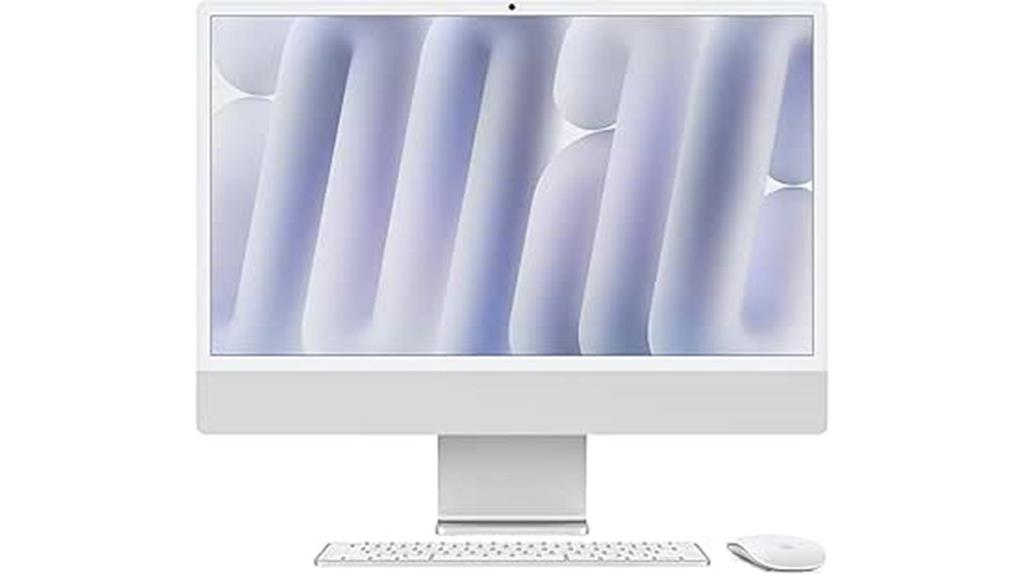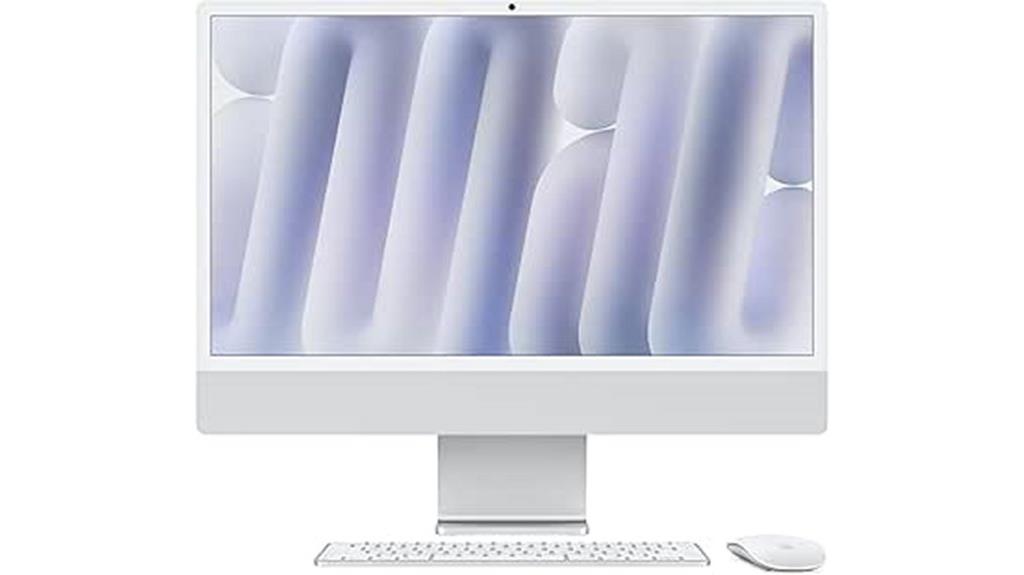If you’re looking for the best iMacs for video editing in 2025, I recommend focusing on machines with powerful M4 chips, high-resolution Retina displays, and ample RAM and storage. Models with fast SSDs and robust graphics deliver smooth performance for demanding projects. These iMacs not only handle 4K and 8K editing easily but also look great on your desk. Keep exploring to find out which options suit your creative needs perfectly.
Key Takeaways
- Select iMac models with 4.5K Retina displays for accurate color grading and vivid visuals.
- Prioritize high-performance M4 chips with multi-core CPUs and GPUs for smooth editing and rendering.
- Opt for models with at least 16GB RAM and fast SSD storage to handle large video files efficiently.
- Choose sleek all-in-one designs with ample internal storage or external drives for large media projects.
- Focus on iMacs with powerful graphics and high VRAM to ensure seamless playback and real-time effects.
Apple 2024 iMac Desktop Computer with M4 Chip

If you’re serious about video editing, the Apple 2024 iMac with the M4 chip is an excellent choice. Its sleek, ultra-thin design comes in vibrant colors like Silver, adding style to any workspace. The 24-inch Retina display with Nano-Texture Glass offers stunning visuals and rich colors, making editing more immersive. Powered by the M4 chip with a 10-core CPU and GPU, it delivers fast, efficient performance for demanding tasks. With 16GB of unified memory and 256GB SSD storage, it handles multiple applications smoothly. Plus, its all-in-one form factor fits seamlessly into any setup, combining power and elegance effortlessly.
Best For: creators and professionals who need a powerful, stylish, and immersive all-in-one desktop for tasks like video editing, graphic design, and multimedia production.
Pros:
- Stunning 24-inch 4.5K Retina display with vibrant colors and Nano-Texture Glass
- Powered by the advanced M4 chip with a 10-core CPU and GPU for fast performance
- Sleek, ultra-thin design available in multiple vibrant colors, including Silver
Cons:
- Limited storage capacity at 256GB SSD, which may require external solutions for large files
- Higher price point may be a consideration for budget-conscious users
- All-in-one design limits upgradeability and customization options
Apple 2024 iMac Desktop Computer with M4 Chip

The Apple 2024 iMac with the M4 chip is an excellent choice for video editors who need stunning visuals and powerful performance in a sleek package. Its 24-inch Retina display offers 4.5K resolution with 500 nits brightness, supporting up to 1 billion colors for vibrant, accurate visuals. Powered by a 10-core CPU and GPU, it handles demanding editing tasks effortlessly. With 16GB of unified memory and a 256GB SSD, it guarantees quick, seamless workflow. The iMac also features a 12MP Center Stage camera, spatial audio, and supports all major editing software. Its vibrant design makes it as stylish as it is capable.
Best For: creative professionals and video editors seeking a sleek, high-performance all-in-one desktop with stunning visuals and powerful processing capabilities.
Pros:
- Vibrant 24-inch Retina display with 4.5K resolution and support for up to 1 billion colors
- Powered by the efficient M4 chip with a 10-core CPU and GPU for demanding tasks
- Sleek, stylish design available in multiple colors, including Blue
Cons:
- Limited storage options starting at 256GB SSD, which may require upgrades for large projects
- Higher price point compared to some traditional desktops with similar specs
- Potential learning curve for users unfamiliar with macOS or Apple ecosystem
Apple 2024 iMac Desktop Computer with M4 Chip

The Apple 2024 iMac with M4 Chip stands out as an excellent choice for video editors who need powerful performance in a sleek, space-saving design. Its 24-inch Retina display with 4.5K resolution and support for up to a billion colors offers stunning visuals, essential for detailed editing. Powered by the M4 chip with a 10-core CPU and GPU, it handles multitasking and rendering smoothly. With 16GB of unified memory and a 512GB SSD, it guarantees fast data access and reliable storage. The all-in-one form reduces clutter, making it perfect for a clean, efficient workspace without sacrificing performance.
Best For: creative professionals and video editors seeking a powerful, stylish, and space-efficient desktop with stunning visuals and seamless performance.
Pros:
- Bright 24-inch Retina display with 4.5K resolution and support for up to a billion colors
- Powerful M4 chip with a 10-core CPU and GPU for smooth multitasking and rendering
- Sleek all-in-one design reduces clutter and enhances workspace aesthetics
Cons:
- Limited to 512GB SSD storage, which may require external drives for large files
- Higher price point compared to some traditional desktops with similar specs
- Limited upgradeability due to its all-in-one construction
Apple 2024 iMac Desktop Computer with M4 Chip

For video editors seeking a powerful and visually stunning all-in-one device, the Apple 2024 iMac with M4 chip is an excellent choice. Its sleek, colorful design and 24-inch Retina display with 4.5K resolution deliver stunning visuals. Powered by the M4 chip with a 10-core CPU and GPU, it handles demanding editing tasks with ease. With 24GB of unified memory and a 512GB SSD, multitasking and data access are smooth and fast. The iMac also features a 12MP Center Stage camera, studio-quality microphones, and six speakers with Spatial Audio, making it perfect for editing, conferencing, and immersive media experiences.
Best For: video editors and creative professionals seeking a powerful, visually stunning all-in-one desktop for demanding editing and multimedia tasks.
Pros:
- Vibrant 24-inch Retina display with 4.5K resolution and support for up to 1 billion colors
- Powered by the efficient M4 chip with a 10-core CPU and GPU for smooth performance
- Immersive audio with six speakers and Spatial Audio, along with a high-quality 12MP Center Stage camera
Cons:
- Limited to 512GB SSD storage, which may require additional external storage for large projects
- The all-in-one design may limit hardware upgrade options over time
- Higher price point compared to some competing all-in-one desktops with similar specifications
Apple 2024 iMac Desktop Computer with M4 Chip

With its powerful M4 chip and stunning 24-inch Retina display, the Apple 2024 iMac is an ideal choice for video editors who need both speed and visual accuracy. The M4’s 10-core CPU and GPU handle demanding tasks effortlessly, ensuring smooth editing workflows. Its 4.5K Retina display supports a billion colors and 500 nits brightness, delivering vivid, true-to-life visuals essential for color grading and detailed work. The all-in-one design saves space and looks sleek on any desk. Coupled with 16GB of unified memory and a 512GB SSD, this iMac offers fast data access and seamless multitasking, making it perfect for professional video editing.
Best For: creative professionals and video editors who need a powerful, visually accurate computer with a sleek all-in-one design.
Pros:
- High-performance M4 chip with a 10-core CPU and GPU for demanding tasks
- Stunning 24-inch 4.5K Retina display supporting a billion colors and high brightness
- Seamless multitasking with 16GB unified memory and 512GB SSD storage
Cons:
- Limited upgradeability due to all-in-one design
- Higher price point compared to some competing desktops with similar specs
- No dedicated graphics card options beyond the M4 integrated GPU
Apple 2024 iMac Desktop Computer with M4 Chip

If you’re looking for a sleek, powerful all-in-one that handles video editing with ease, the Apple 2024 iMac with M4 chip is an excellent choice. Its 24-inch Retina display with 4.5K resolution and support for a billion colors offers stunning visuals, perfect for detailed editing. Powered by the M4 chip with an 8-core CPU and GPU, it delivers swift performance. With 16GB of unified memory and fast 256GB SSD storage, multitasking and file handling are smooth. Its vibrant design options and seamless macOS integration make it not only functional but also a stylish addition to any workspace.
Best For: creative professionals and power users who need a stylish, high-performance all-in-one desktop for video editing, design, and multitasking.
Pros:
- Stunning 24-inch 4.5K Retina display with support for a billion colors provides excellent visual clarity.
- Powerful M4 chip with an 8-core CPU and GPU delivers fast, efficient performance for demanding tasks.
- Seamless integration with macOS and compatibility with Adobe Creative Cloud and Microsoft 365 enhances productivity.
Cons:
- Limited storage capacity at 256GB SSD may require external storage for large files.
- The all-in-one design, while sleek, offers less upgradeability compared to traditional desktops.
- Higher price point may be a consideration for budget-conscious users.
Factors to Consider When Choosing an Imac for Video Editing

When choosing an iMac for video editing, I focus on several key factors to guarantee smooth performance. I consider the processing power, display quality, memory, storage, and graphics capabilities to meet my editing needs. These elements help me select a machine that handles demanding projects efficiently and reliably.
Processing Power Needs
Choosing the right iMac for video editing hinges largely on its processing power, since editing high-resolution footage and rendering complex projects demand a robust CPU. A multi-core processor, especially with 8 or more cores, is vital for efficient rendering and encoding, markedly reducing export times. Integrated GPUs with high core counts are essential for smooth playback and real-time editing of 4K or higher resolutions. Additionally, ample RAM—16GB or more—is necessary to handle large files and multitasking. Fast storage options, like SSDs with higher capacities, guarantee quick access to files and seamless editing of large assets. Overall, investing in a powerful processor and supporting components guarantees a smoother workflow and faster project turnaround.
Display Resolution Quality
The display resolution quality of an iMac directly impacts how accurately and comfortably I can edit videos. Higher resolutions like 4.5K or 5K deliver sharper, more detailed images, making it easier to spot fine nuances and make precise adjustments. Support for up to a billion colors ensures color grading is accurate and vibrant, which is vital for professional-quality videos. A display brightness of at least 500 nits helps maintain visibility even in bright environments and enhances contrast for better color accuracy. Anti-reflective coatings like Nano-Texture Glass reduce glare, reducing eye strain during long editing sessions. Additionally, the pixel density and resolution allow me to view fine details without zooming or needing external monitors, streamlining my workflow and improving overall editing precision.
Memory Capacity Requirements
Have you ever experienced lag or long rendering times while editing videos? That’s often a sign your system isn’t equipped with enough RAM. For smooth editing, I recommend at least 16GB of RAM, but if you’re working with 4K or higher resolution footage, 32GB or more is ideal. More memory allows your editing software to run efficiently alongside other applications, which is essential during complex projects with multiple layers and effects. Without enough RAM, you’ll face lag, longer rendering times, and decreased overall performance—especially with large files. Upgrading to a system with ample memory not only improves current workflows but also future-proofs your setup, helping you handle more demanding projects and software updates down the line.
Storage Space Adequacy
When selecting an iMac for video editing, storage space plays a significant role in guaranteeing smooth workflows. I recommend a minimum of 512GB of SSD storage to comfortably handle large video files and project assets. If you work with high-resolution 4K or 8K footage regularly, opting for 1TB or more is wise to prevent frequent external drive dependence. Speed matters too; faster SSDs reduce load and save times, boosting efficiency. Remember, external storage options like Thunderbolt or USB-C drives can supplement internal space for extensive projects. Additionally, consider future needs—larger storage capacities can extend your iMac’s usefulness as your projects grow in size. Balancing capacity, speed, and budget ensures you won’t outgrow your device prematurely.
Graphics Performance Level
Ever wondered how your iMac’s graphics performance impacts your video editing? The answer is simple: it’s essential. A higher graphics performance level ensures smoother playback and faster rendering of high-resolution videos, cutting down lag and processing times. A dedicated GPU or a high-core-count integrated GPU can greatly boost real-time editing and handle complex visual effects more efficiently. VRAM capacity is also critical—more VRAM lets you work seamlessly with large files and demanding projects without slowdowns. Plus, a GPU that supports advanced APIs like Metal improves compatibility with professional editing software and plugins, providing better acceleration and stability. In short, investing in a powerful GPU directly translates to a more efficient, smoother editing experience—making it a key factor when choosing your ideal iMac.
Connectivity Options
Choosing the right connectivity options on your iMac is essential for a smooth video editing workflow. I look for models with multiple Thunderbolt 4 or USB-C ports, ensuring fast data transfer from external drives and peripherals. High-speed Wi-Fi 6E or Ethernet is vital for uploading, downloading, and collaborating online without lag. If I need to connect additional monitors or external displays, I check for HDMI or other video output ports. Bluetooth 5.0 or higher is also important for wirelessly connecting external audio equipment, controllers, or accessories. Additionally, I verify compatibility with external SD card readers or media input devices to streamline footage import directly into my editing setup. These connectivity options help maintain an efficient, seamless editing experience.
Software Compatibility
To guarantee smooth video editing, I prioritize verifying that the iMac’s macOS version supports the latest editing software like Adobe Premiere Pro and Final Cut Pro. Ensuring compatibility means checking that the hardware specifications—CPU, GPU, and RAM—meet or exceed the recommended requirements for fluid performance. I also verify that the editing apps are optimized for Apple Silicon architecture, which enhances stability and speed. Additionally, I confirm the iMac has the necessary connectivity options, such as Thunderbolt or USB-C ports, for external drives and peripherals vital to editing workflows. Finally, I review whether the software leverages features like GPU acceleration and hardware encoding, ensuring my iMac configuration supports advanced editing capabilities for efficient and seamless production.
Price and Budget
While verifying software compatibility guarantees my iMac can handle video editing tasks smoothly, considering the price and my budget helps me find a model that offers the right balance of performance and affordability. Setting a budget narrows down options and guarantees I choose a device that fits my financial plan. Higher-priced models often come with faster processors, more RAM, and larger storage, which are advantageous for editing workflows. However, I need to balance these features with the minimum hardware specs required for smooth performance, like a swift CPU and enough memory. Also, I should factor in the costs of accessories or software needed for professional editing. Comparing prices across retailers or waiting for sales can help me maximize my budget and get the best value for my money.
Frequently Asked Questions
How Does the Display Color Accuracy Impact Video Editing?
Display color accuracy is vital for video editing because it ensures that the colors I see on screen match the final output. When the display is accurate, I can trust my color grading and corrections, making my videos look professional and consistent across different devices. Poor color accuracy can lead to mismatched colors, which might require re-editing later. So, a precise display helps me produce high-quality, true-to-life videos efficiently.
Can I Upgrade the RAM or Storage Later?
Think of your iMac like a sturdy bookshelf; I can add more shelves later to hold extra books. Similarly, I can upgrade the RAM and storage later, depending on the model. For some iMacs, especially the newer ones, upgrades are limited or require professional help. So, I recommend choosing a model with ample RAM and storage upfront to avoid restrictions later.
What Software Compatibility Issues Should I Consider?
You should check if your preferred editing software is tailored for macOS and the latest hardware. Some apps might need updates to run smoothly on newer Macs, especially those with Apple Silicon chips. Also, verify if plugins or third-party tools you rely on are compatible. I always look at software developer websites or user forums to ensure there are no surprises, so my workflow stays seamless.
How Does Thermal Management Affect Performance During Long Editing Sessions?
Ever wondered how thermal management impacts your editing sessions? It’s vital because good heat dissipation keeps your iMac running smoothly, preventing overheating that can throttle performance. During long editing projects, efficient cooling maintains consistent speed and responsiveness, avoiding lag or crashes. A well-designed thermal system ensures your iMac stays cool under pressure, so you can focus on your creative work without worrying about performance drops caused by heat buildup.
Is There a Significant Difference in Editing Performance Between Models With M4 Chips?
Yes, there’s a noticeable difference in editing performance between models with M4 chips. I’ve found that higher-tier M4 chips offer faster processing, smoother multitasking, and better handling of intensive editing tasks. The improvements in CPU and GPU power mean I can work more efficiently without lag or overheating issues. If you’re serious about editing, investing in a model with a more powerful M4 chip definitely pays off in performance and workflow.
Conclusion
If you’re serious about video editing, choosing the right iMac can make all the difference. With Apple’s latest M4 chip, performance skyrockets—up to 40% faster than previous models, according to recent benchmarks. Remember, the right specs can substantially cut down rendering times and boost productivity. So, invest wisely, and you’ll enjoy smoother edits and stunning visuals. After all, in 2025, staying ahead means having the best tools—your creative edge depends on it.




